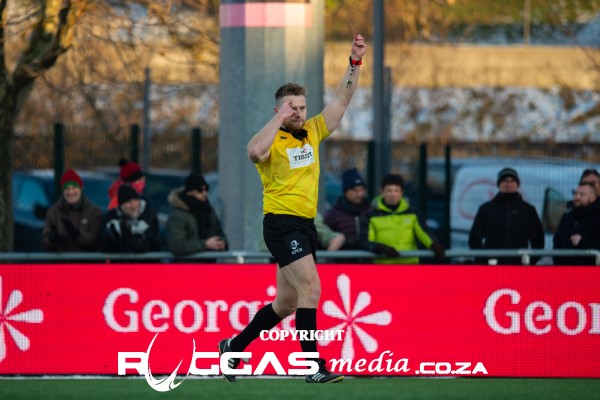
The Vodacom United Rugby Championship will adopt the global World Rugby trial of the 20-minute red card law for the 2025/26 season. The trial is designed to protect player welfare, improve accuracy in key decisions, and ensure the game remains fair and competitive for players, teams and fans.
What is the 20-Minute Red Card?
- If a player commits foul play that reaches the red card threshold but is not deliberate or “always illegal,” they will receive a 20-minute red card.
- The player is removed from the game and cannot return.
- After 20 minutes of playing time, the team may bring on an available replacement.
Two yellow cards to the same player in one match will also equal a 20-minute red card.
By contrast, permanent red cards will still apply where foul play is highly dangerous, intentional, or “always illegal.” In these cases, only the referee can make the decision, and the player is sent off for the rest of the game and cannot be replaced.
Examples of 20-Minute Red Cards
- A shoulder charge to the head with low danger or indirect contact.
- A tackle or in a ruck clear-out attempt where a player makes head contact despite a genuine attempt to wrap.
- High-danger foul play that is not deemed deliberate or always illegal.
Examples of Permanent Red Cards
- A shoulder charge to the head with high force and direct contact.
- Highly dangerous, clear out directly onto or land on an opponent’s lower limbs at a ruck.
- Punching, kicking, headbutting, verbal abuse or any form of violent conduct or acts of ‘thuggery’.
How the Process Works in the URC
Each game will have four officials: referee, two assistant referees and a Television Match Official (TMO).
If foul play occurs:
1. The referee may consult with the TMO and issue a permanent red card for clear, intentional, high-danger incidents.
2. If the incident meets at least the yellow card threshold, the referee may show a yellow card with arms crossed above the head, signalling an off-field review.
3. The player leaves the field for 10 minutes while the TMO reviews the footage.
4. Within eight minutes of playing time, the TMO must review all relevant footage and recommend to the referee that the sanction should:
Remain a yellow card, or be upgraded to a 20-minute red card.
1. If upgraded, the referee makes the decision and shows a red card. The player cannot return, but a replacement is allowed after 20 minutes.
2. The TMO cannot upgrade a yellow card to a permanent red card; only the referee can give a permanent red card.
Recent Posts
- DHL Stormers Made To Work Hard For Win Over Benetton
- Hollywoodbets Sharks Edge Scarlets Rugby For First Win in 2025/26 United Rugby Championship
- Lions Stun Ulster With Sparkling Rugby At Ellis Park
- DHL Stormers Should Cruise To A Win Over Benetton?
- Hollywoodbets Sharks And Scarlets Both Desperate For A Win
- Ulster Must Be The Favourite At Ellis Park
- Ten Minutes Of Madness Once Again Cost Vodacom Bulls Against Glasgow Warriors
- History Beckons In Pick n Pay Gold Cup Final
- Toyota Cheetahs Change Five And Name New Captain For Second Toyota Challenge Match Against Black Lion
- DHL Stormers Change Eight For Benetton
- Lions Change Three For Vital Clash Against Ulster In Johannesburg
- “The Ability Is There, The Skill Is There, But We Tend To Switch Off” – Johan Ackermann
- Frans Steyn Insists On A Much-Improved Performance Against Black Lion
- Teamwork And Cohesion Will Be Key For The Hollywoodbets Sharks Against The Scarlets
- An All-Out War Is Expected When Vodacom Bulls Meet Glasgow Warriors
